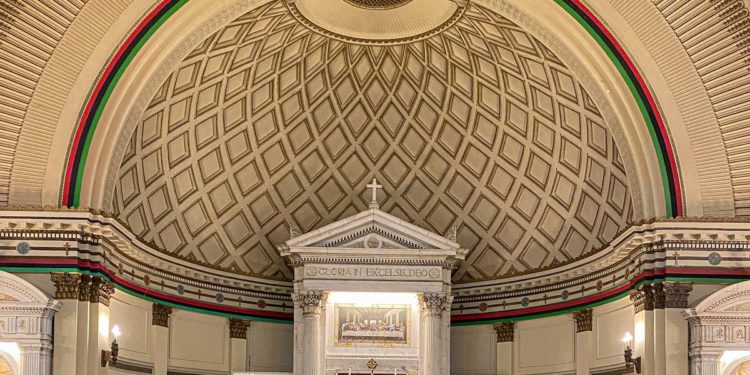Corpus Christi Roman Catholic Church was built for the ages.
Built in 1916 on the southwest corner of 49th Street and Dr. Martin Luther King Jr. Drive, the Italian Renaissance revival-styled limestone church is a study in permanence — a rock that has weathered the Great Depression and decades of economic and social changes in Bronzeville.
Designed by architect Joseph W. McCarthy, Corpus Christi had 3,000 worshipers, a school and a convent during its heyday from the 1930s to the 1950s.
But after services Sunday, Corpus Christi will lock its bronze doors and close the grounds’ ornate wrought-iron gates for the last time.
That’s because the Chicago Roman Catholic Archdiocese is consolidating five predominantly Black churches on the South Side — Corpus Christi, St. Ambrose, St. Anselm, St. Elizabeth and Holy Angels — into a new single parish called Our Lady of Africa.
Once the doors of Corpus Christi are shut, the city will lose an interior of uncommon beauty. The church features an eye-popping vault-like ceiling with nearly 600 detailed octagonal coffers.
:no_upscale()/cdn.vox-cdn.com/uploads/chorus_asset/file/22682542/5X9A4464.jpg)
The treasure of stained-glass windows by the noted craftsman F.X. Zettler, depicting scenes such as the Eucharist, are bright and almost three-dimensional in depth and detail.
A lovely and contemplative enclosed courtyard — it looks like a small slice of Italy brought to the South Side — will be closed off.
The church’s historian Larry Cope, a graphic designer, rightly called all he surveyed “beautiful” during our Friday walk through the edifice. What he said next was also true:
“It’s really costly to maintain this,” he said. “And with our congregation down to 100 to 150 members, we really couldn’t keep it up.”
:no_upscale()/cdn.vox-cdn.com/uploads/chorus_asset/file/22682549/5X9A4603.jpg)
Holy Angels will be the new parish’s home. St. Elizabeth, 50 E. 41st St., will become a heritage center for the Rev. Augustus Tolton, who escaped enslavement and became the country’s first recognized Black Catholic priest.
:no_upscale()/cdn.vox-cdn.com/uploads/chorus_asset/file/22682568/AFF0506C_BC27_4534_8C6C_AE5CDBAB5B54.jpeg)
There are no immediate plans for Corpus Christi, St. Ambrose and St. Anselm. Their statuary, murals and other religious finery will be stored until they find their way to other churches in the archdiocese.
:no_upscale()/cdn.vox-cdn.com/uploads/chorus_asset/file/22682560/5X9A4578.jpg)
Cope and others are grateful the church’s work can contribute with the new consolidated parish.
“The church is not a building,” Cope said. “It’s the people.”
Lee Bey, former architecture critic for the Chicago Sun-Times, is the author of “Southern Exposure: The Overlooked Architecture of Chicago’s South Side” and a member of the Sun-Times editorial board.
Credit: Source link




